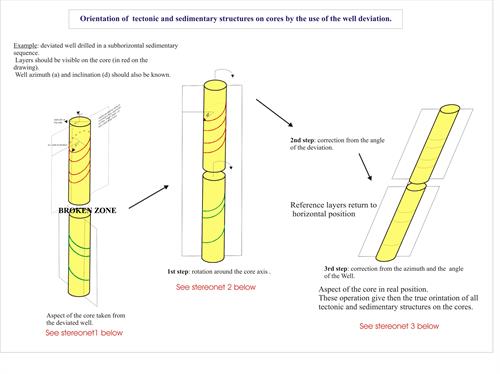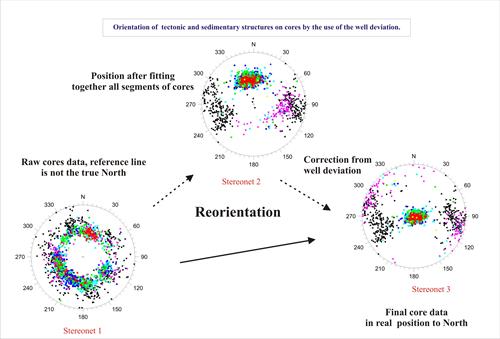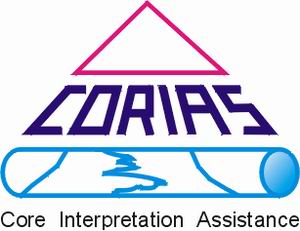Corias - Core Interpretation Assistance - 74, Allee de la Robertsau F-67000 Strasbourg
Phone: +33.3.88.24.24.00 - Mobile: +33.6.07.56.11.78 -
Mail: christian@corias.com
© Corias 2025 - All rights reserved.
In the case of a non oriented coring, the geological planes and lines collected on the cores with the AS3D are oriented by reference to an arbitrary reference line, drawn on the cores after careful reconstitution of the core fragments to obtain a maximum connected length. The reference scribe line is drawn and recorded on each connected length of core.
In the data processing, the “raw data” that is oriented with reference to the scribe lines are reoriented into the real geographic position as follows:
The coupled software package of the AS3D system allows instantaneous plotting of diagrams such as Stereonet plots and core logs.
These two types of diagrams are plotted for the raw data of each scribe line. On these diagrams, the orientation of each geological plane is designated by a colour and shape code.
The geologic spatial organisation is characterised generally by the individualisation of different families for planes such as open fractures, cemented fissures, bedding planes, stratification joints, appear then on the Stereonet in specific areas.
The process of the reorientation of data with well deviation is reported on the figures below.
Figure 1 shows the various steps, starting from data collection of low dipping sedimentary layers with apparent high dip due to well inclination (core on the left). In the example of well deviated about 45°, the raw sedimentary and tectonic data plotted on Stereonet appear with no clear azimuth and apparent dip of 45°.
Then in step-1 the data have been grouped by type (fractures, bedding, etc.) in a process that rotates all non-connected core pieces in order to fit the same area (Stereonet 2). In the second step, the sedimentary data are turned to fit with the azimuth of the well deviation.
In the last step, the data are corrected from the well inclination angel: bedding move to low dips and fractures move to high dips. The data are reoriented.


Remark: this type of reorientation process is used only when the cores are taken from zones where the sedimentary dips are known to be low. In case of deviated wells in zones with high dips (fold, tilted blocks...) another process should be used.
The high precision of the AS3D system, the knowledge of our geologists and the possibility to collect lots of data in a very short time increase the accuracy of such method for re-orientation of cores.
Reorientation with deviated well


